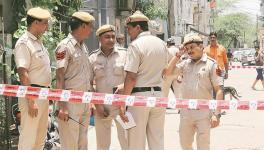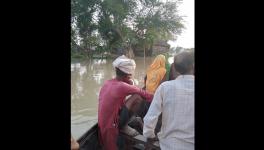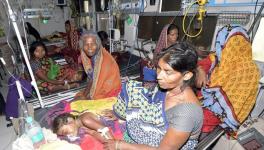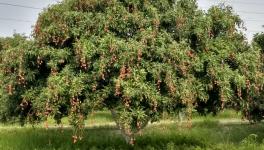Deadly AES Affects Children from Poorest of the Poor families in Muzaffarpur, Survey Reveals
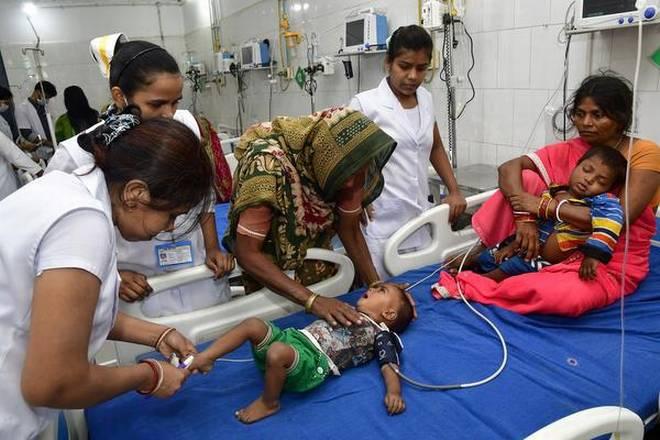
Image Courtesy: The Hindu
The menace of Acute Encephalitis Syndrome (AES), which has almost presumed epidemic proportion in Bihar’s Muzaffarpur district, has mostly affected the children from the poorest of the poor. This can be gauged from the fact that the more than 130 children who have died due to AES in Muzaffarpur in the last twenty days and those who are still suffering from it, are children of landless farm labourers, daily wage workers, seasonal labourers and people earning livelihood by doing odd jobs.
All this was revealed in a socio-economic survey conducted among 289 out of over 500 AES affected families. Though the survey is not over and the final report is yet to be submitted, one of the district administration officials involved in the survey told NewsClick on Monday, June 24, that majority of the AES-hit families are poverty stricken and from the lower strata of the society.
As per the survey, most of the affected children were in the age of 1-11 years. Majority of them were malnourished and living in poor conditions in villages, particularly in dalit hamlets like Mushahar Toli, Paswan Toli and Chamar Toli.
“Of 289 AES affected families, 96 families have no ration cards and 124 do not get any food grains through the public distribution system. Majority of those surveyed were deprived from the benefit of welfare schemes like food security,” the senior official said.
Also read: Most AES Victims in Bihar Are Dalits, EBCs and Muslims
According to the survey, out of the 289 families surveyed, only 29 are beneficiaries of the Mukhyamantri Kanya Suraksha Yojana and 98 were covered under the Indira Awas Yojana. But not a single family was beneficiary of the much hyped Jal Nal Yojana (tap drinking water) of the state government. The annual income of the affected families was estimated to be between Rs 30,000 to 70,000.
Muzaffarpur district magistrate Alok Ranjan Ghosh told NewsClick that data collection of the survey is still going on and not yet analysed fully. “We are working along with Jeevika workers to collect data of more than 500 families affected by AES in the villages. Data collection is in final stage,we will analyse and made the findings public soon.”
DM Ghosh said official teams have been collecting data by visiting villages and directly approaching affected families to know their food security, purchasing power, house and living condition as well as annual income.
Satyam Kumar Jha, a young activist camping in rural Muzaffarpur, said, “Dalit children are malnourished, not immunised and are more prone to consumption of contaminated water, which makes them an easy target of AES.”
Doctors and experts, who have investigated to find the cause of deaths of children from AES, point to malnutrition as one of the main factors behind children’s vulnerability to the disease. This was iterated by the latest National Family Health Survey (NHFS 2015-16) that pointed out high rates of malnutrition among children under five years of age in Bihar.
Health officials, who have been closely monitoring AES for several years, said malnutrition among dalit children is common due to prevalence of poverty.
The survey was taken up after Chief Minister Nitish Kumar visited Muzaffarpur on last Tuesday, June 18, and directed the survey to be carried out in blocks or villages where the reported death toll is high. It was decided that the survey will study socio-economic profiles of people, particularly affected families and the environment they live in.
“For the first time, such a survey is being conducted. This would help in understanding the ground reality and how to tackle the disease, which is still unknown and to take serious measures to combat its outbreak during summer annually,” a senior health official told NewsClick.
More than over two decades after AES first struck Muzaffarpur as an epidemic, the disease not only persists but also continues to spread among the poorer sections. Estimates say that more than 85% of the victims belong to the socially marginalised section – comprising mostly dalits along with Extremely Backward Classes (EBC) and Muslims. This disease is estimated to have killed more than 400 children in last seven to eight years and affected hundreds.
Take the case of dalit families in Dariyapur and Dhoriya villages under Minapur block – where five children died due to AES – many villagers are still living without toilets, forced to go for open defecation along with the lack of safe drinking water. They are living in thatched houses surrounded by filth.
One thing is certain, doctors and health officials have different views on the reason behind AES and cause of the deaths. It has further complicated the process to combat or control the seasonal outbreak of AES in northern Bihar, which has been recurring every year.
None other than the State Chief Secretary Deepak Kumar publicly admitted that even the government is unclear about what exactly was causing the AES outbreak, which has been recorded in Muzaffarpur since 1995. “We are still not aware if the disease is caused due to some virus, bacteria, toxic effect due to consumption of litchi, malnourishment or due to environmental conditions such as high temperature and humidity. Several researches have been done, including by a team of experts from the Centre for Disease Control, Atlanta, but the findings are inconclusive.”
Also read: AES Deaths: SC Asks Centre, Bihar Govt to Respond in 7 days
Get the latest reports & analysis with people's perspective on Protests, movements & deep analytical videos, discussions of the current affairs in your Telegram app. Subscribe to NewsClick's Telegram channel & get Real-Time updates on stories, as they get published on our website.












